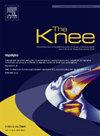Joint distraction versus custom-made unloading orthosis for knee osteoarthritis – A clinical and radiological study
IF 2
4区 医学
Q3 ORTHOPEDICS
引用次数: 0
Abstract
Background
A promising treatment option to postpone knee replacement is knee joint distraction (KJD). This treatment shows clinical and radiological improvements, but is invasive, with substantial adverse effects. A custom-made orthosis was developed for unloading the knee, striving for comparable clinical outcomes with KJD with less side effects. The aim of this study is to evaluate the effectiveness of a KJD for 6 weeks compared to a knee-unloading orthosis for 8 weeks on clinical outcomes, progression of osteoarthritis and adverse events.
Methods
Two cohort studies investigating different treatments (KJD vs orthosis) for patient with severe knee osteoarthritis (Kellgren-Lawrence grades 2–4), age ≤ 65 were compared. During the 2 year follow-up, clinical outcome was assessed using the Western Ontario and McMaster Universities Osteoarthritis and numeric rating scale for pain. Progression of osteoarthritis was determined by the radiographic minimum joint space width (mJSW); adverse events were obtained from the charts.
Results
In both patient groups (KJD: n = 21; orthosis: n = 10) significant clinical improvement was found during the 2-years follow-up. For the KJD group the median mJSW increased from 0.0 at baseline to 0.9 mm at one- and two-year follow-up; in the orthosis group the mJSW remained 0.0 during all time-points. Adverse events were reported in 86 % of the KJD patients versus 30 % in the orthosis group.
Conclusion
Both KJD and unloading orthosis treatment improves clinical outcome for at least 2 years in patients ≤ 65 years. Only KJD influenced progression of osteoarthritis, but had more side effects compared with the orthosis treatment.
膝关节骨关节炎的关节牵引与定制卸载矫形器-临床和放射学研究
背景:推迟膝关节置换术的一个有希望的治疗选择是膝关节牵拉术(KJD)。这种治疗显示出临床和放射学上的改善,但它是侵入性的,有很大的不良反应。我们开发了一种定制的矫形器来卸载膝关节,力求达到与KJD相当的临床结果,而且副作用更少。本研究的目的是评估6周KJD与8周卸膝矫形器在临床结果、骨关节炎进展和不良事件方面的有效性。方法对年龄≤65岁的严重膝关节骨性关节炎(Kellgren-Lawrence分级2-4)患者进行两项队列研究,比较不同治疗方法(KJD与矫形器)。在2年的随访中,临床结果使用西安大略大学和麦克马斯特大学骨关节炎和疼痛数值评定量表进行评估。骨性关节炎的进展由x线片最小关节间隙宽度(mJSW)确定;从图表中获得不良事件。结果两组患者(KJD: n = 21;矫形:10例患者在2年随访中均有显著临床改善。对于KJD组,中位mJSW从基线时的0.0增加到1年和2年随访时的0.9 mm;矫形器组mJSW在所有时间点保持0.0。86%的KJD患者报告了不良事件,而矫形器组为30%。结论对于≤65岁的患者,KJD和卸荷矫形器治疗均可改善至少2年的临床结果。仅KJD影响骨关节炎的进展,但与矫形器治疗相比有更多的副作用。
本文章由计算机程序翻译,如有差异,请以英文原文为准。
求助全文
约1分钟内获得全文
求助全文
来源期刊

Knee
医学-外科
CiteScore
3.80
自引率
5.30%
发文量
171
审稿时长
6 months
期刊介绍:
The Knee is an international journal publishing studies on the clinical treatment and fundamental biomechanical characteristics of this joint. The aim of the journal is to provide a vehicle relevant to surgeons, biomedical engineers, imaging specialists, materials scientists, rehabilitation personnel and all those with an interest in the knee.
The topics covered include, but are not limited to:
• Anatomy, physiology, morphology and biochemistry;
• Biomechanical studies;
• Advances in the development of prosthetic, orthotic and augmentation devices;
• Imaging and diagnostic techniques;
• Pathology;
• Trauma;
• Surgery;
• Rehabilitation.
 求助内容:
求助内容: 应助结果提醒方式:
应助结果提醒方式:


